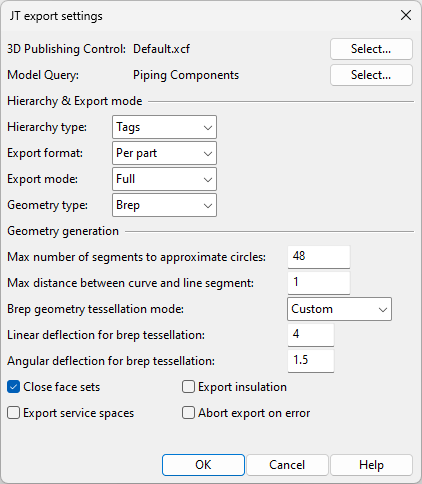JT export settings
In the JT export settings dialog, you can specify settings for exporting 3D model objects in JT format.
Exports can be performed manually, as described in JT export, or scheduled, as described in Scheduling model export.
- 3D Publishing Control – Click Select to choose which 3D publishing control to use in the export.
- Model Query – Click Select to choose which model query to use for selecting the objects to be exported.
Hierarchy & Export mode
-
Hierarchy type – Specify what defines the hierarchy to use in the JT file.
-
Export format – Specify whether to export one file or multiple files.
- Per part – Export each part to a separate JT file.
- Monolithic – Export all parts to a single JT file.
-
Export mode – Specify whether to export all objects or only the changed ones. This is applicable only when exporting each part to a separate file.
- Full – Always export all objects that match the query.
- Update – After the first export only export the changes: new, modified, or deleted objects. Typically this option provides faster exports, but this can depend on the geometry and the number of exported objects.
-
Geometry type – Specify the geometry export type.
- Brep – All geometry will be exported as complete, and the exported data can be used for generation of 2D drawings, for example.
- Polygonset – All geometry will be exported as surfaces. This is typically faster and suitable for use in viewers.
Geometry generation
-
Max number of segments to approximate circles – Specify the maximum number of segments to use to approximate circles in primitives that are exported as face sets.
-
Max distance between curve and line segment – Specify the maximum distance between a curve and an approximating polyline that are exported as face sets.
-
Brep geometry tessellation mode – Specify the tessellation mode for brep geometry.
-
Low, Medium, High – Select one of these to apply predefined values for linear deflection and angular deflection.
-
Custom – Select this to define linear deflection and angular deflection manually.
-
Linear deflection — Specify the maximum distance between an imported higher-order surface (such as spline surface, which are typical for Mechanical CAD models) and its triangulated approximation, using a value from 0.5 to 32.
-
Angular deflection — Specify the maximum angle between neighboring (approximated) triangles, using a value from 0.5 to 16.
-
-
-
Close face sets – Select this option to specify that primitives exported as face sets should have closed ends.
-
Export service spaces – Select this option to export service spaces linked to model objects even if the model query does not select the service spaces.
-
Export insulation – Select this option to export insulation as objects.
-
Abort export on error – Select this option to specify that encountering problematic object geometries should stop and cancel the export. If using a Plant Modeller Service Instance for export, a log file by the name <export_filename>.failed_objects.txt is written into the output directory.
